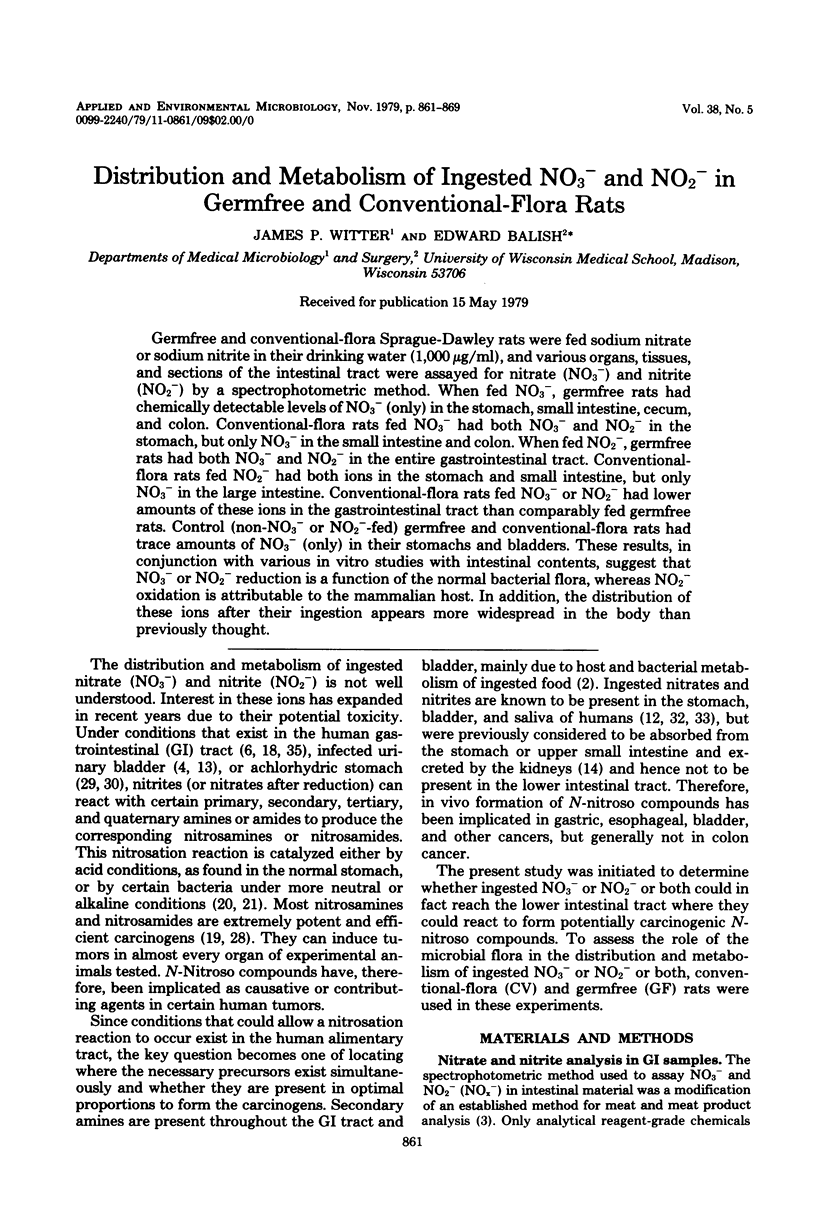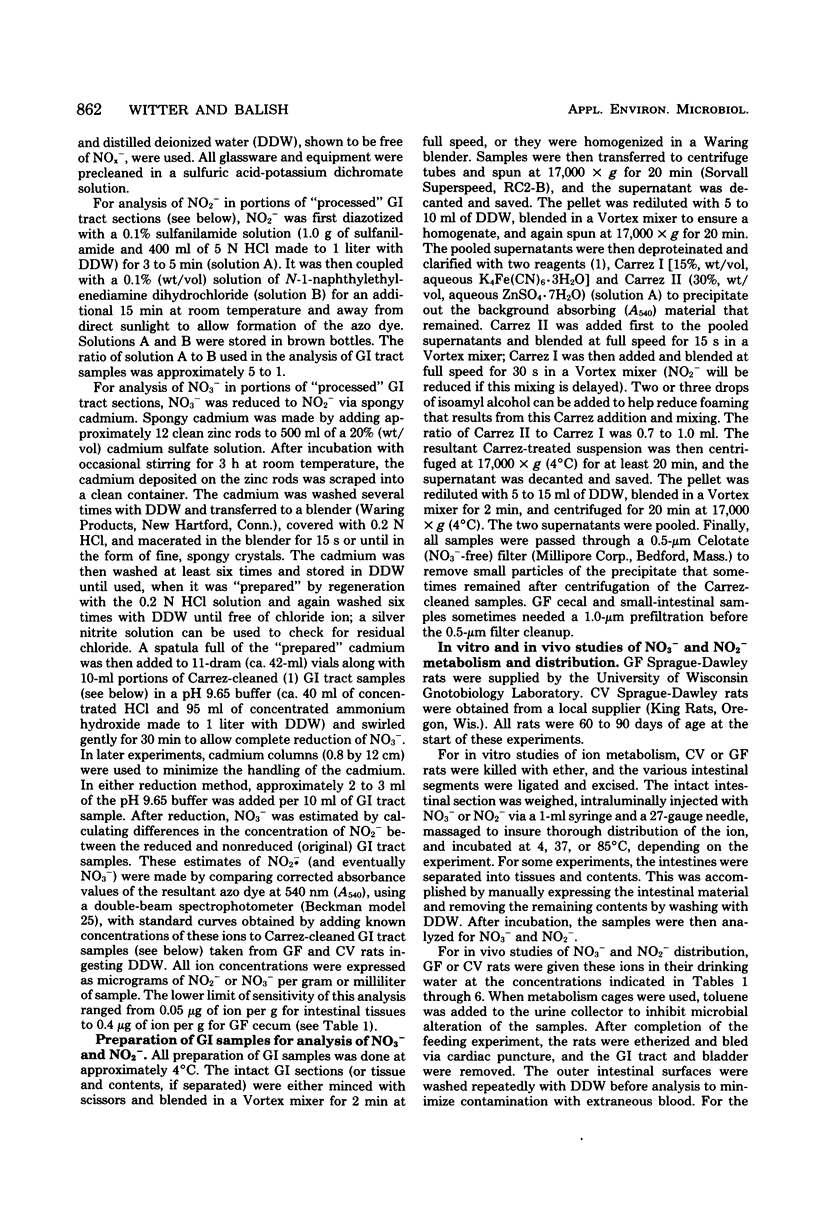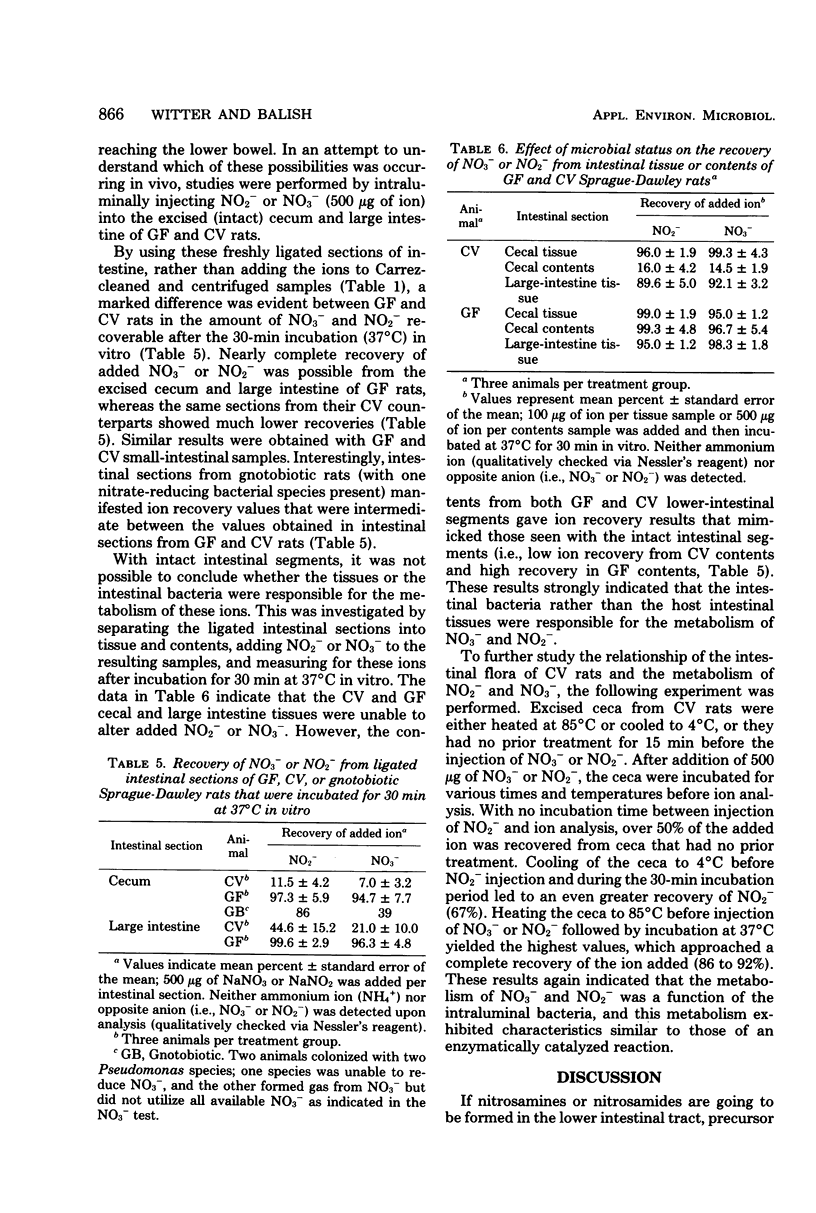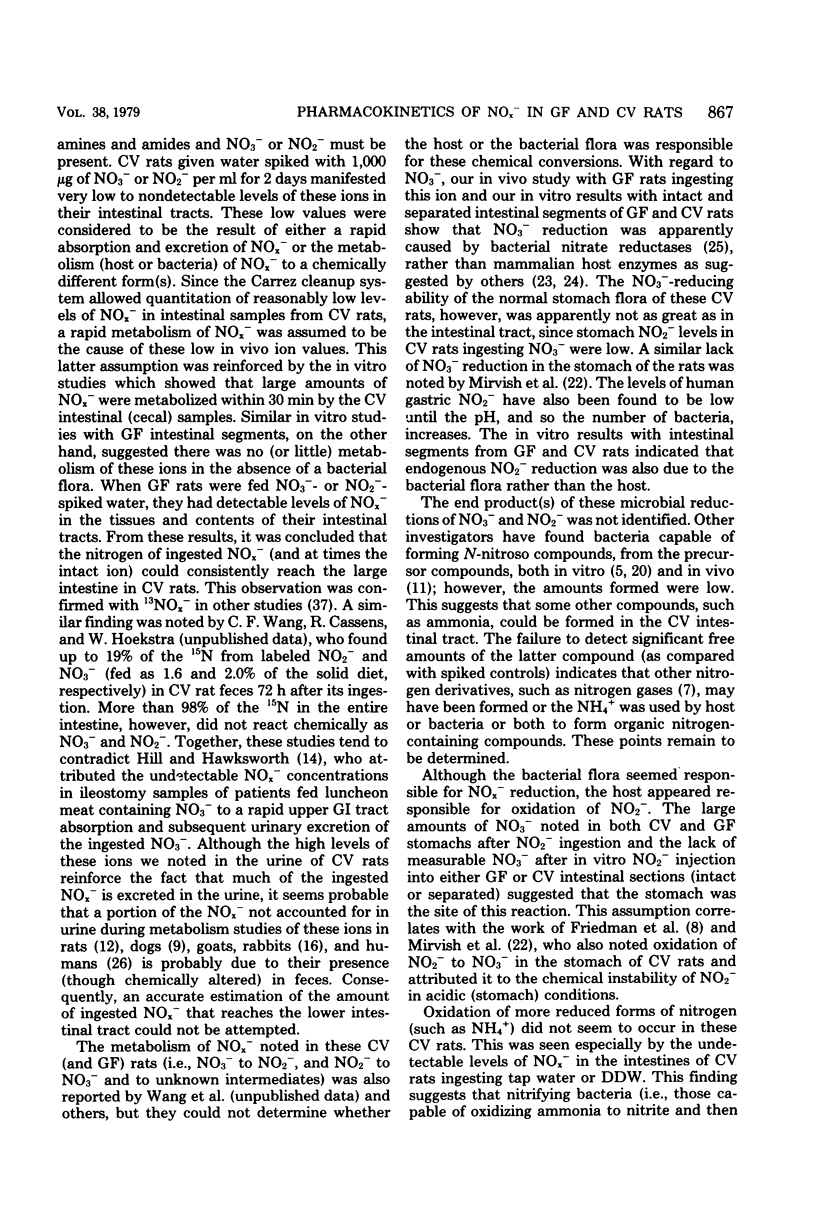Abstract
Germfree and conventional-flora Sprague-Dawley rats were fed sodium nitrate or sodium nitrite in their drinking water (1,000 microgram/ml), and various organs, tissues, and sections of the intestinal tract were assayed for nitrate (NO3-) and nitrite (NO2-) by a spectrophotometric method. When fed NO3-, germfree rats had chemically detectable levels of NO3- (only) in the stomach, small intestine, cecum, and colon. Conventional-flora rats fed NO3- had both NO3- and NO2- in the stomach, but only NO3- in the small intestine and colon. When fed NO2-, germfree rats had both NO3- and NO2- in the entire gastrointestinal tract. Conventional-flora rats fed NO2- had both ions in the stomach and small intestine, but only NO3- in the large intestine. Conventional-flora rats fed NO3- or NO2- had lower amounts of these ions in the gastrointestinal tract than comparably fed germfree rats. Control (non-NO3- or NO2--fed) germfree and conventional-flora rats had trace amounts of NO3- (only) in their stomachs and bladders. These results, in conjunction with various in vitro studies with intestinal contents, suggest that NO3- or NO2- reduction is a function of the normal bacterial flora, whereas NO2- oxidation is attributable to the mammalian host. In addition, the distribution of these ions after their ingestion appears more widespread in the body than previously thought.
Full text
PDF








Selected References
These references are in PubMed. This may not be the complete list of references from this article.
- Adriaanse A., Robbers J. E. Determination of nitrite and nitrate in some horticultural and meat products and in samples of soil. J Sci Food Agric. 1969 Jun;20(6):321–325. doi: 10.1002/jsfa.2740200601. [DOI] [PubMed] [Google Scholar]
- Asatoor A. M., Chamberlain M. J., Emmerson B. T., Johnson J. R., Levi A. J., Milne M. D. Metabolic effects of oral neomycin. Clin Sci. 1967 Aug;33(1):111–124. [PubMed] [Google Scholar]
- Brooks J. B., Cherry W. B., Thacker L., Alley C. C. Analysis by gas chromatography of amines and nitrosamines produced in vivo and in vitro by Proteus mirabilis. J Infect Dis. 1972 Aug;126(2):143–153. doi: 10.1093/infdis/126.2.143. [DOI] [PubMed] [Google Scholar]
- Coloe P. J., Hayward N. J. The importance of prolonged incubation for the synthesis of dimethylnitrosamine by enterobacteria. J Med Microbiol. 1976 May;9(2):211–223. doi: 10.1099/00222615-9-2-211. [DOI] [PubMed] [Google Scholar]
- Fine D. H., Ross R., Rounbehler D. P., Silvergleid A., Song L. Formation in vivo of volatile N-nitrosamines in man after ingestion of cooked bacon and spinach. Nature. 1977 Feb 24;265(5596):753–755. doi: 10.1038/265753a0. [DOI] [PubMed] [Google Scholar]
- Friedman M. A., Greene E. J., Epstein S. S. Rapid gastric absorption of sodium nitrite in mice. J Pharm Sci. 1972 Sep;61(9):1492–1494. doi: 10.1002/jps.2600610937. [DOI] [PubMed] [Google Scholar]
- GREENE I., HIATT E. P. Behavior of the nitrate ion in the dog. Am J Physiol. 1954 Mar;176(3):463–467. doi: 10.1152/ajplegacy.1954.176.3.463. [DOI] [PubMed] [Google Scholar]
- Hashimoto S., Yokokura T., Kawai Y., Mutai M. Dimethylnitrosamine formation in the gastro-intestinal tract of rats. Food Cosmet Toxicol. 1976 Dec;14(6):553–556. doi: 10.1016/s0015-6264(76)80007-7. [DOI] [PubMed] [Google Scholar]
- Hawksworth G. M., Hill M. J. Bacteria and the N-nitrosation of secondary amines. Br J Cancer. 1971 Sep;25(3):520–526. doi: 10.1038/bjc.1971.66. [DOI] [PMC free article] [PubMed] [Google Scholar]
- Hicks R. M., Gough T. A., Walters C. L. Demonstration of the presence of nitrosamines in human urine: preliminary observations on a possible etiology for bladder cancer in association with chronic urinary tract infection. IARC Sci Publ. 1978;(19):465–475. [PubMed] [Google Scholar]
- Keating J. P., Lell M. E., Strauss A. W., Zarkowsky H., Smith G. E. Infantile methemoglobinemia caused by carrot juice. N Engl J Med. 1973 Apr 19;288(16):824–826. doi: 10.1056/NEJM197304192881606. [DOI] [PubMed] [Google Scholar]
- Lijinsky W. Nitrosamines and nitrosamides in the etiology of gastrointestinal cancer. Cancer. 1977 Nov;40(5 Suppl):2446–2449. doi: 10.1002/1097-0142(197711)40:5+<2446::aid-cncr2820400909>3.0.co;2-q. [DOI] [PubMed] [Google Scholar]
- Mills A. L., Alexander M. N-Nitrosamine formation by cultures of several microorganisms. Appl Environ Microbiol. 1976 Jun;31(6):892–895. doi: 10.1128/aem.31.6.892-895.1976. [DOI] [PMC free article] [PubMed] [Google Scholar]
- Mirvish S. S. Formation of N-nitroso compounds: chemistry, kinetics, and in vivo occurrence. Toxicol Appl Pharmacol. 1975 Mar;31(3):325–351. doi: 10.1016/0041-008x(75)90255-0. [DOI] [PubMed] [Google Scholar]
- Mirvish S. S., Patil K., Ghadirian P., Kommineni V. R. Disappearance of nitrite from the rat stomach: contribution of emptying and other factors. J Natl Cancer Inst. 1975 Apr;54(4):869–875. [PubMed] [Google Scholar]
- Payne W. J. Reduction of nitrogenous oxides by microorganisms. Bacteriol Rev. 1973 Dec;37(4):409–452. doi: 10.1128/br.37.4.409-452.1973. [DOI] [PMC free article] [PubMed] [Google Scholar]
- Radomski J. L., Palmiri C., Hearn W. L. Concentrations of nitrate in normal human urine and the effect of nitrate ingestion. Toxicol Appl Pharmacol. 1978 Jul;45(1):63–68. doi: 10.1016/0041-008x(78)90028-5. [DOI] [PubMed] [Google Scholar]
- Reddy B. S., Watanabe K., Weisburger J. H., Wynder E. L. Promoting effect of bile acids in colon carcinogenesis in germ-free and conventional F344 rats. Cancer Res. 1977 Sep;37(9):3238–3242. [PubMed] [Google Scholar]
- Sander J., Seif F. Bakterielle Reduktion von Nitrat im Magen des Menschen als Ursache einer Nitrosamin-Bildung. Arzneimittelforschung. 1969 Jul;19(7):1091–1093. [PubMed] [Google Scholar]
- Sander J. Untersuchungen über die Entstehung cancerogener Nitrosoverbindungen im Magen von Versuchstieren und ihre Bedeutung für den Menschen. 1. Arzneimittelforschung. 1971 Oct;21(10):1572–1580. [PubMed] [Google Scholar]
- Segal H. L., Samloff I. M. Gastric cancer--increased frequency in patients with achlorhydria. Am J Dig Dis. 1973 Apr;18(4):295–299. doi: 10.1007/BF01070990. [DOI] [PubMed] [Google Scholar]
- Tannenbaum S. R., Fett D., Young V. R., Land P. D., Bruce W. R. Nitrite and nitrate are formed by endogenous synthesis in the human intestine. Science. 1978 Jun 30;200(4349):1487–1489. doi: 10.1126/science.663630. [DOI] [PubMed] [Google Scholar]
- Tannenbaum S. R., Weisman M., Fett D. The effect of nitrate intake on nitrite formation in human saliva. Food Cosmet Toxicol. 1976 Dec;14(6):549–552. doi: 10.1016/s0015-6264(76)80006-5. [DOI] [PubMed] [Google Scholar]
- Walters C. L., Hill M. J., Ruddell W. S. Gastric juice nitrite its source and relationship to hydrogen ion concentration. IARC Sci Publ. 1978;(19):279–288. [PubMed] [Google Scholar]
- Wang T., Kakizoe T., Dion P., Furrer R., Varghese A. J., Bruce W. R. Volatile nitrosamines in normal human faeces. Nature. 1978 Nov 16;276(5685):280–281. doi: 10.1038/276280a0. [DOI] [PubMed] [Google Scholar]
- Weisburger J. H., Reddy B. S., Wynder E. L. Colon cancer: its epidemiology and experimental production. Cancer. 1977 Nov;40(5 Suppl):2414–2420. doi: 10.1002/1097-0142(197711)40:5+<2414::aid-cncr2820400904>3.0.co;2-d. [DOI] [PubMed] [Google Scholar]
- Whelan M. The nitrate content of animal tissues, and the fate of ingested nitrate. Biochem J. 1935 Mar;29(3):782–787. doi: 10.1042/bj0290782. [DOI] [PMC free article] [PubMed] [Google Scholar]
- Witter J. P., Balish E., Gatley S. J. Distribution of nitrogen-13 from labeled nitrate and nitrite in germfree and conventional-flora rats. Appl Environ Microbiol. 1979 Nov;38(5):870–878. doi: 10.1128/aem.38.5.870-878.1979. [DOI] [PMC free article] [PubMed] [Google Scholar]


